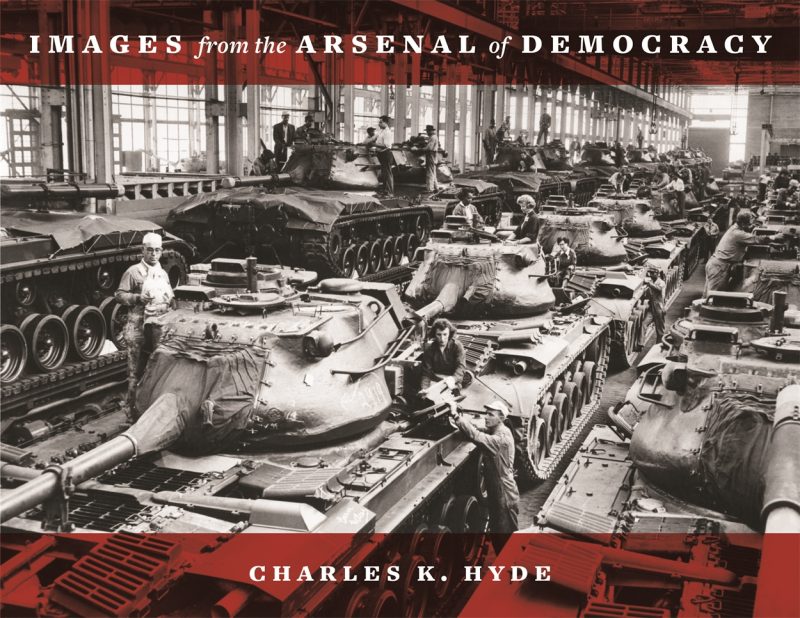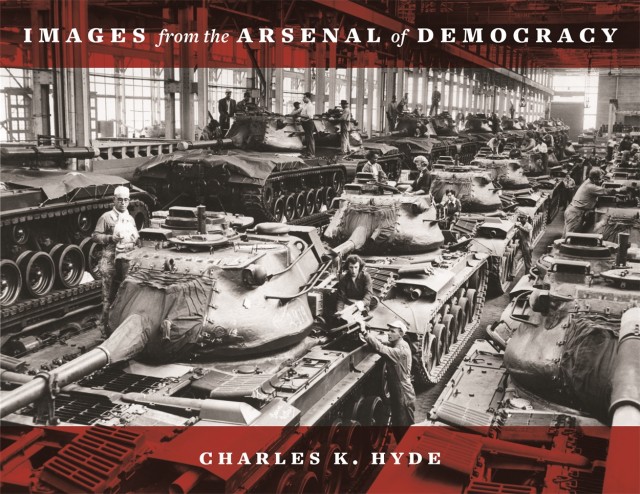A work colleague of mine called me over to look at a page from the Times Literary Supplement, a worthy title I work on every so often. Amid the deeply highbrow stuff was a snap showing a Pershing tank production line. Naturally, I was intrigued. The photo led me to the Wayne University Press in Detroit; an organisation I suspect would be outside the orbit of most military history buffs, especially beyond the United States. The good people there sent me this book at some expense and I am so glad they did. It is magnificent.
Americans awake! The 70th anniversary of D-Day has passed and there are other glories yet to recall from Europe and the Pacific before we reach the milestones of victory dates in the second half of 2015. This book will show you that your victory in World War II and the immense economic and military power you have possessed ever since 1945 was not solely won on the battlefields but in your own backyard – in the factories of America. It was won by the architects, auto industry executives and ordinary men and women who produced hundreds of thousands of vehicles, aircraft, munitions and engines that powered the Allied victory against the Axis evil.
The book focuses on the plants where the foundations of victory were laid. We see the construction of huge new factories that made all this possible with the corresponding issues of expanding housing, transport and other infrastructure essential to the lives of the army of people doing the vital manufacturing work. There is a chapter on the change the war forced on a traditionally white male dominated industry as ethnic minorities and especially women came to the fore.
But the real meat and drink is the archive photography depicting war weapons under construction. The phases of production and the immense amount of machinery produced by the American auto industry and it’s many component suppliers is bewildering, with everything from tanks to binoculars represented.
We see all the major food groups, whether your interest is planes, tanks or trucks and with the latter the author singles out the obvious classics of the species. As a professional photo archives man I find these images fascinating. The quality of the photography is outstanding and the care in setting up some of the shots is apparent. I suppose it would be daft to expect anything less given the propaganda value of it all and the immense resources thrown at showing how America was winning the war.
While the author is clever to allude to the iconic image of Rosie the Riveter and her many sisters there is so much more to the story and it is pretty much all here in a master class on how to produce a pictorial book. The captions offer a mass of information on processes and statistics in addition to notes on some of the key men leading the industrial surge. My mate Mike in Ohio is a big fan of these factory scenes, especially when they depict a Sherman tank. There are several here, but there is so much more with a wide range of locations and specialities included.
Automotive historian Charles K Hyde produced this book almost as an afterthought to a previous work on the industry during WWII. In effect it should broaden the appeal to a much wider audience who have an interest in the weaponry, are proud of the immense achievement of the workforce or just enjoy high quality photo archive books. While some beautiful colour images of women working in the factories have done the rounds in recent times, this is a purely black and white book but this does nothing to diminish the impact.
This book goes beyond depicting a triumph in American history. It should encourage similar works concentrating on the immense efforts made in Canada, the UK and Australasia to produce war-winning goods. The quality of the photo books on Pearson’s of Liverpool, where so many of the vehicles arriving from North America were assembled emphasises the connection.
I have admired these sort of images for many years and only recently scanned plates from the British factories of Boulton Paul, Vickers and Short Brothers. The photographs have an immense impact. They show how the war was total and that everyone had a part to play. My mother left school in 1944 and went straight to work in an army shirt factory, aged 14, operating amid the bomb-scarred ruins of her London neighbourhood. There is nothing glamorous or unusual in recording the fact, but she did her bit like so many thousands of others. These things matter.
The combat victories and the sacrifices made collectively and individually must never be forgotten, but nor should the contribution of the people in industries who produced the tools that won our freedom. This book should help that notion along and I urge you to get a copy. You will not be disappointed.
Review by Mark Barnes for War History Online
IMAGES FROM THE ARSENAL OF DEMOCRACY
By Charles K Hyde
Wayne University Press
ISBN: 978 0 8143 3981 7 (print)
ISBN: 978 0 8143 3982 4 (Ebook)

